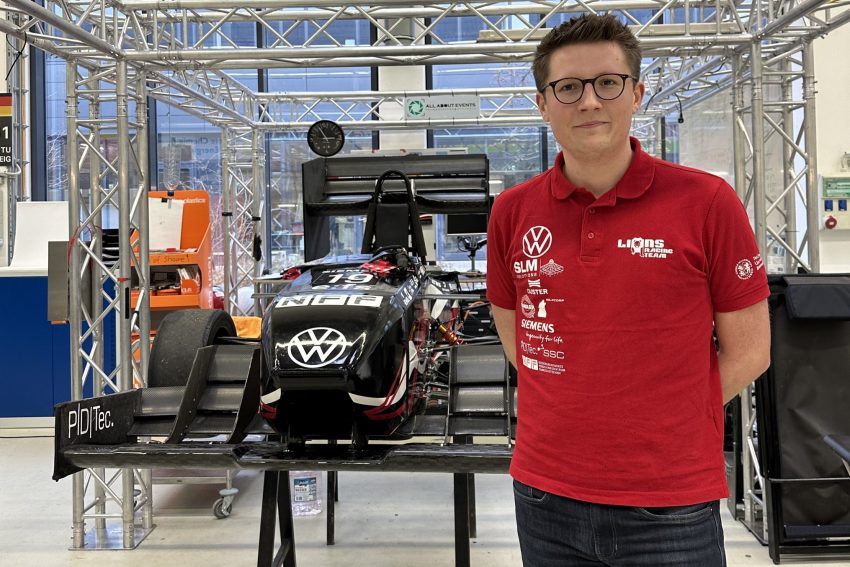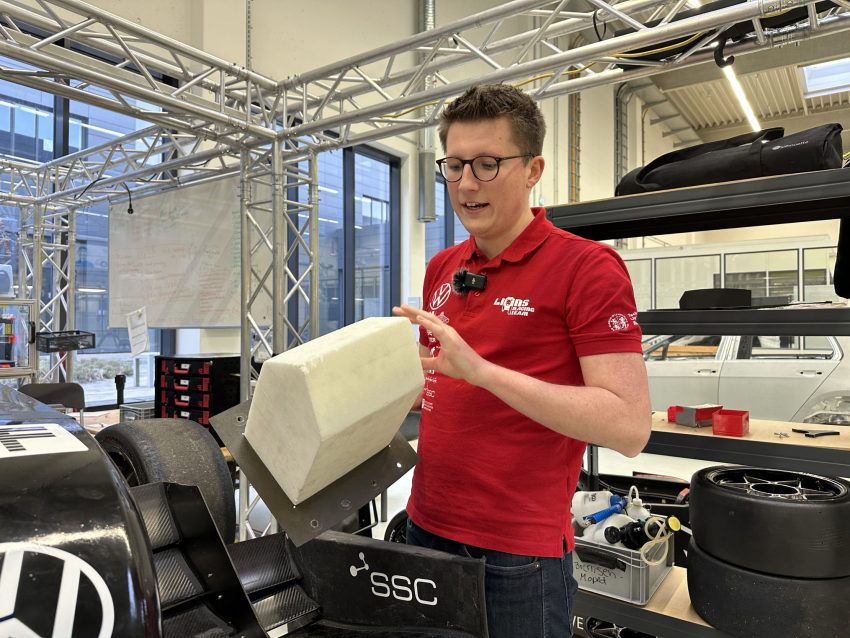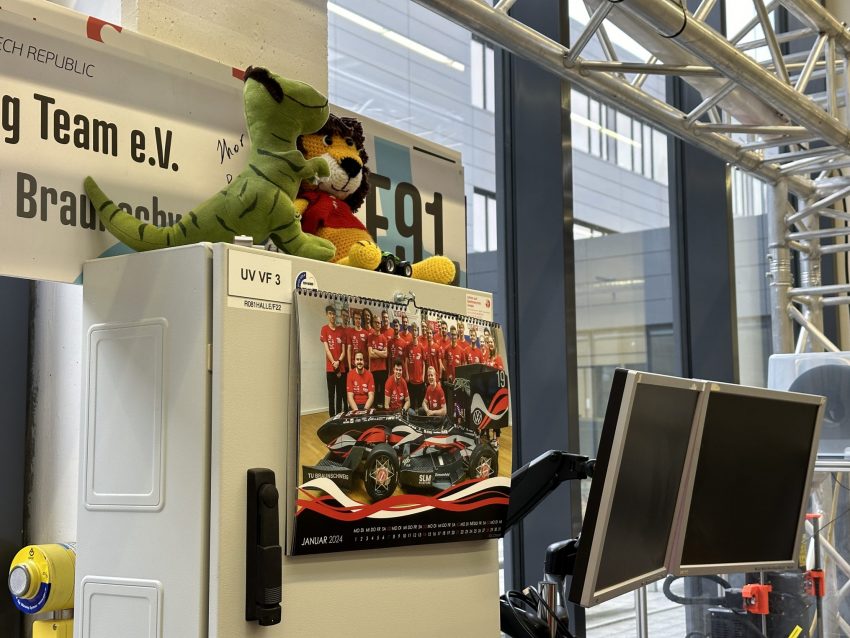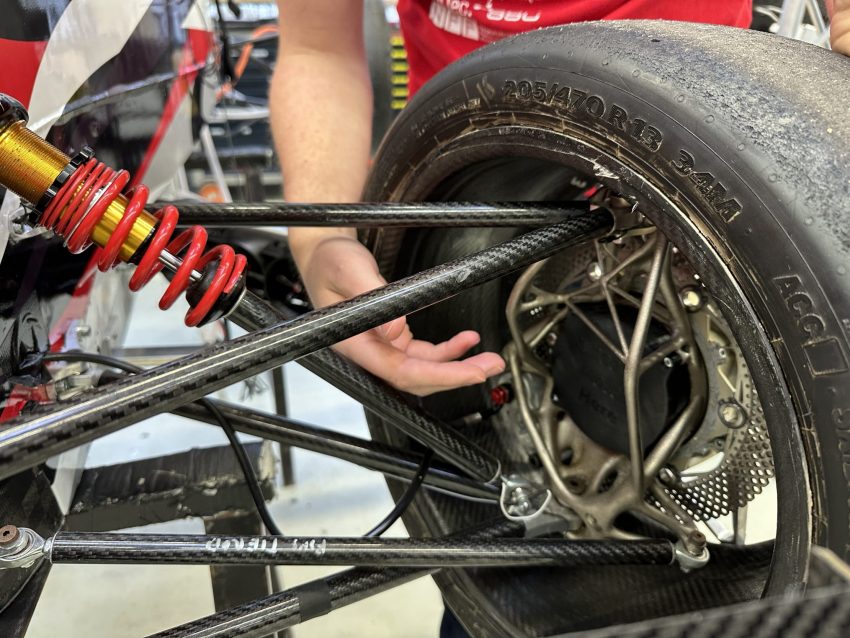Fast & Furious to the perfect race car Student team builds its own race car for the “Formula Student” competition series
Lightning-quick starts, breathtaking speeds, spectacular overtaking manoeuvres: in the race for records, the highest level of engineering skill is required when building racing cars. At TU Braunschweig, students in the Lions Racing Team student association have the opportunity to develop their own racing car during their studies, gain valuable practical experience and compete against other universities. The road to success is paved with “sweat and tears”, a unique team spirit, career-boosting networks and the odd setback.

Maximilian Eins is the head of recruitment at the Lions Racing Team.
Photo credits: Dilara Aktaş/TU Braunschweig
It is an impressive racing car in the workshop hall of Niedersachsen Automotive Research Centre (NFF). Over three metres in length, weighing 210 kilos, capable of speeds of 125.6 km/h and accelerating from 0 to 100 in just three seconds. The rear of the car is labelled “May contain traces of the LR22”, due to the reuse of some parts from the old car. The car, unassumingly named ‘LR 24’, was built by Lions Racing students with one goal in mind: to win competitions

The LR24 can accelerate from 0 to 100 km/h in just three seconds.
Photo credits: Lions Racing Team/TU Braunschweig
This does not refer to a Formula 1 Grand Prix, but a Formula Student competition: every year, more than 500 university teams from over 60 countries develop, design and build a racing car to compete against each other in various disciplines. “It’s not just about driving as fast as possible: engineering performance and technical understanding are at the heart of the competition,” says Maximilian Eins. He is the head of recruitment for the Lions Racing Team, which currently consists of around 50 members and is constantly growing at the beginning of the semester.
Engineering meets team spirit
Many of the team members come from the traditional engineering degree programmes, but there is also a place for people from all other fields. An architecture student takes care of the design, while business students are needed for the business plan or marketing. “There is a task for everyone, and everyone contributes to the overall success with their individual skills.”
Just like a company, the team structure is made up of different departments, each taking care of a specific aspect of the race car. Aerodynamics & Fibre Composites, Powertrain & Electronics, Driverless Driving, Driving Dynamics, Performance, Statics as well as Organisation & Marketing. Once a week, in addition to the weekly team meeting, the individual departments meet to discuss department-specific tasks. Sponsors meetings are also important to get sponsors on board, because building a race car is expensive. For the team members, the sponsor network often opens doors for dissertations, internships, student jobs or even careers. In addition, there are training courses and workshops on technical basics and joint team events such as bowling or trampoline parks. To get in shape for the driving disciplines and to develop grip strength and body tension, some of the group go bouldering every Wednesday at Greifhaus. All to ensure that thy are well prepared for the competition season.
The competition format
The season starts in the spring with the registration quizzes. The aim is to prove your theoretical knowledge of racing car construction against other teams worldwide and to win starting places for the competitions in the summer. This year the quizzes went particularly well for the Lions Racing Team. “We were able to qualify directly for the events in Germany and Switzerland. Above all, the direct qualification for Formula Student Germany was a great success.”
The actual competitions, divided into static and dynamic events, take place in July and August. The static competition is about the interdisciplinary approach behind the technical construction. The judging criteria include business plan, cost and manufacturing, and technical design. In addition to the classic Formula 1 circuit races, acceleration, the dynamic events will also test and evaluate acceleration, endurance and efficiency. Driverless driving is a separate discipline. New this year: only electric vehicles may be used. The aim is to build the racing car of the future. For Maximilian, the team spirit between the teams is also something special about these competitions. “Everyone there knows how much sweat, blood and tears have gone into this project and we are happy to help other teams when they need it.”
Early end for the LR24

Some parts of the LR24 will be used in the new race car, the LR25.
Photo credits: Dilara Aktaş/ TU Braunschweig
It is all the more disappointing that the LR24 never made it onto the track. Technical problems with the battery prevented it from taking part in the racing season. Instead, last season was used to evaluate, test and improve the car so that everything runs smoothly in 2025. It is now also clear that the LR24 will no longer exist. “Once we’ve completed our final tests, we’ll gradually dismantle it and incorporate some of its components into a new race car, the LR25.”
In general, the autumn season is a time of upheaval for the team. Some long-standing members have completed their studies during the summer semester and are no longer with us. The task now is to form a new team and see who is best suited to which department.
Become part of the team with mulled wine and BBQ
For all those who want to become part of the Lions Racing Team and get the LR25 ready for the new season: An information evening will take place on 13 November at 6 p.m. at Langen Kamp 6. With mulled wine and a barbecue, interested students from TU Braunschweig can get an insight into the work of the team and ask questions in a relaxed atmosphere. There will also be the opportunity to apply for a place on the team directly online.


